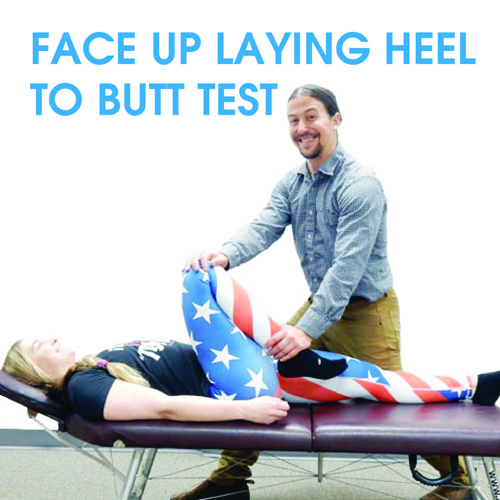
18 Jun Know Your Numbers: The Face-Up Heel to Butt Test
Your wallet is stuck in your knee joint. ~Barefoot Rehab
The ability to differentiate a knee joint problem (the ‘ol wallet in the door syndrome) from a quadriceps muscle problem can save the knee from imminent surgery.
That’s what we’ll discuss here.
Mobility: Face-Up Heel to Butt Test | Supine Knee Flexion (SKF)
The ability to bring one’s heel to her butt is something that anyone should be able to do, when healthy. The “Face-Up Heel to Butt Test”, or in mechanical terms, supine knee flexion, will let us know if you have that ability.
What do I need to Measure this Test? You will need a flat surface to lie on, a ruler, and a friend to help you measure this test.
What is the Face-Up Heel to Butt Test assessing? The mobility of your knee joint integrity. These structures include bone, ligaments, tendons, cartilage, menisci, and muscles (vastus medialis, vastus intermedius, and vastus lateralis). This test is NOT testing rectus femoris. To test rectus femoris, you can either do the Face-Down version of this test or secondarily, do the lunge stretch test while selectively tensioning the knee.
What Specific Dysfunctions are relevant here? Besides adhesion of the three structures that limit knee flexion, there are several knee pathologies that can permanently limit the range: osteoarthritis, joint inflammation, cartilage or mensicus pathologies will show up with this test.
Your friend can feel the different between muscle and joint by what the range of motion feels like at the end range.
- A soft, springy end-feel = muscle restriction.
- A hard, cement-life stop to your end-feel + “wincing” + a comment to your friend “slow down, be careful” = joint restriction.
What You Need to Know: If you have a joint restriction, don’t bother stretching any knee tissues. You can stretch until the cows come home and your range of motion will not increase. See a qualified therapist/healthcare provider before performing any activity with high knee load.
How to Test:
Lie on the ground. Your friend should take your leg and push your heel to your butt. Have him/her be gentle with your leg, especially if you’ve had any knee joint issues or ACL/MCL/meniscus problems in the past.
If your heel is close to your butt, you can measure the distance from the butt with finger breadths (see below). If you’re very restricted, use a ruler to see how far your heel is from your butt.
Write this number down. Any mobilization, stretching, or treatment interventions are attempts to increase this number. If the number isn’t increased after a month, you’re wasting your time.
PASS:
A pass for this test is the ability to bring your heel to your butt.
- Range: Touching
- Effort: Fast and easy.
- Symptoms: No symptoms. No symptoms includes the feeling of a stretch. Ideally, there would be no stretch.
FAIL – LOW RISK:
A fail with a low risk of injury is anywhere from the heel touching the butt to 2 finger breadths away.
- Range: 0 – 2 finger breadths.
- Effort: Fast and easy.
- Symptoms: You may feel a pull in quad. This is indicative of one of the vastus muscles having adhesion.
FAIL – HIGH RISK:
A fail with a high risk of injury is anywhere more than 2 finger breadths away.
- Range: More than 2 finger breadths away.
- Effort: May be slow, labored, or guarded.
- Symptoms: Same as the “fail – low risk”. You may feel a pull in the quad. This is indicative of vastus muscle adhesion. This will be springy at the end range. If it’s a hard-stop or if you wince, this is usually individual of a joint pathology (osteoarthritis, inflammation, cartilage, or meniscus issue). If your range of motion is too much to even measure, I recommend you consult with a musculoskeletal specialist or surgeon before starting any movement routine that will stress your knees.
I Know My Numbers – What do I do now?
Insanity: doing the same thing over and over again and expecting different results. ~Albert Einstein
There are a plethora of mobility and stretching resources out in the interweb for you to experiment with. It is not our intention to give prescriptive answers, simply to bring awareness to where your body currently is in time.
Use whatever tools you’d like to use for a month, stretching about ten minutes a day, for three days a week, for a month.
After a month, re-test.
If you’ve gained range of motion, wonderful! Wash, rinse, repeat, and continue stretching.
If you’re no more flexible or mobile than you were before, STOP THE INSANITY AND THE STRETCHING! It’s now time to see a Manual Adhesion Provider or Active Release Technique Provider to diagnose your condition and potentially remove the adhesion in relevant tissue to restore your mobility before you go on layering strength on top of unhealthy tissue.
While you’re awaiting 30 days from now to reassess, you might as well get baseline measurements for your hip flexion, hip extension, ankles and your low back.
 What are you numbers? Please share range, effort, and symptoms below and we can discuss what you should be doing to restore musculoskeletal integrity.
What are you numbers? Please share range, effort, and symptoms below and we can discuss what you should be doing to restore musculoskeletal integrity.

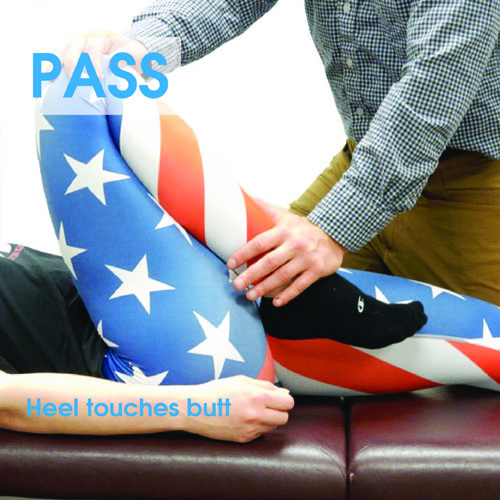
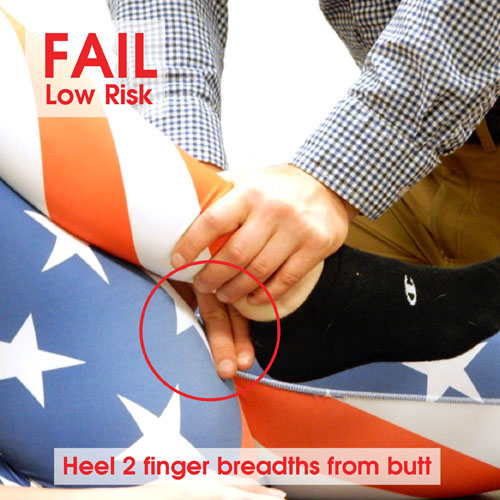
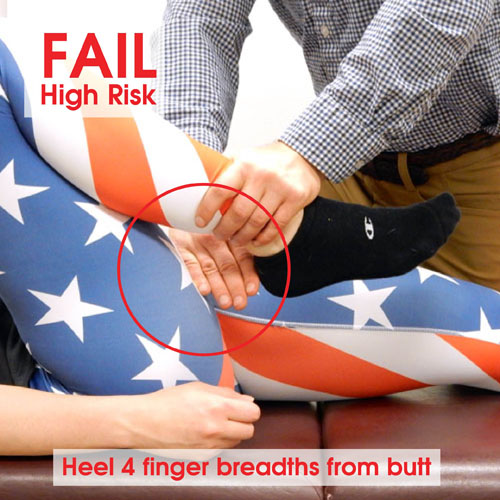
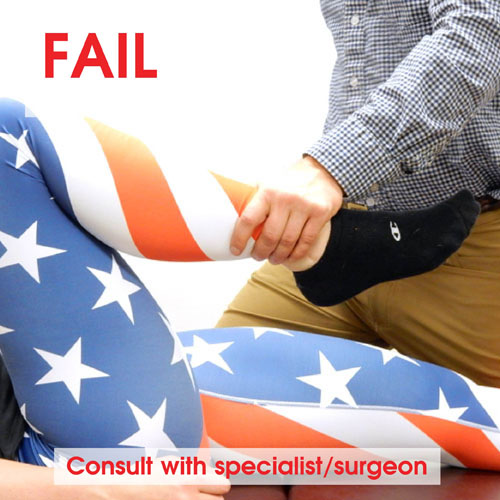

Know Your Numbers: The Face-Up Heel to Butt Test | Primal Docs
Posted at 05:05h, 19 June[…] Know Your Numbers: The Face-Up Heel to Butt Test […]
Avoid the Most Common Running Injuries
Posted at 22:59h, 11 July[…] Face-Up Lying Heel to Butt Test […]
Know Your Numbers: Face Down Heel to Butt Test
Posted at 17:44h, 16 July[…] is a more advanced test than theFace-Up Heel to Butt […]
Ken Robert
Posted at 06:33h, 09 SeptemberI’m sorry are you really claiming that people that don’t have heel to butt mobility are actually at higher risk of injury? Do you have any peer reviewed research to back that up?
Dr. Chris
Posted at 10:34h, 09 SeptemberHi Ken, 100% claiming that, primarily in the knee joint, and a little in ankle due to plantar flexion. No, I do not have peer-reviewed research. If you don’t have 100% range of motion in any joint, there’s a combo of A) Adhesion and/or B) degeneration. Continued use (and load) on a knee with A) and B) means higher risk of injury.
Brandon T
Posted at 03:12h, 10 SeptemberI actually hit a muscle lockout before being able to touch my heel to my butt. My calf muscle sits on my hamstrings and does not allow this range of motion due to muscle mass. Is this going to cause problems?
Dr. Chris
Posted at 09:04h, 11 SeptemberWhile it may seem like it’s a “muscle lockout”, I’ve found that even massive body-builders with enormous mass can touch the heel to the butt. That’s because healthy muscles are soft like raw pieces of steak and squish. Do you have any symptoms anywhere? Still, the most probable cause of this restriction is the knee joint or adhesion in the knee capsule. Yes, any restriction in flexibility puts us at some risk of injury or premature aging. The greater the restriction, the greater the risk.
Jeffery S Quillen
Posted at 23:00h, 24 JulyHow often should I do this stretch. I am currently self rehabbing a knee sprain until I can see an ortho.
I dont have full ROM in my left knee (full hand span). my right knee can touch my glute after a few seconds of stretching.
If you can please explain this whole process to me
Dr. Chris
Posted at 22:20h, 27 JulyHi Jeff – that depends. Is it adhesion in quad,capsule or a knee inflammation/degenerative issue. If your symptoms are behind the knee, I’d stop stretching as you’ll make joint degeneration worse. If you’ve been stretchign over 2 weeks and you’re not sustainably more flexible then I’d also stop stretching. If your range is improving, it’s probably safe to stretch and I’d keep doing so.
Jeffery S Quillen
Posted at 15:59h, 29 JulyI dont know exactly, but i was doing this stretch regularly for a week with both knees and I did regain some flexibility
Is it safe to do it every day? I did it four times a day for about 2 minutes on both knees. My right knee eventually reached my glute. The left still has a way to go.
I stopped stretching my right knee every day,, only once a week, and I am continuing the stretching the left.
If I can describe it to you, I just have tightness in the left. Its just difficult to bend sometimes.
Dr. Chris
Posted at 14:05h, 30 JulyIf the left has improved, it’s safer to keep going. N0tice progress. If there’s no progress, stop and get checked out.
Jeffery S Quillen
Posted at 19:01h, 30 Julyso far yes. I feel it is working. What do i do once after reach full ROM? how do i maintain it?
Dr. Chris
Posted at 21:51h, 01 AugustIf you DO NOT have a knee joint pathology, it will stay by itself.
If you DO, you’ll lose it fast.
Regardless, you should strengthen your glutes, hamstrings, and calves as much as possible. Glute bridges, hamstring bridges, deadlifts (if you can handle them), all to take stress off the knee and quads.
Jeffery S Quillen
Posted at 03:25h, 27 AugustHello, thought id recap! I have been making wonderful progress since my last message. I continued doing the heel to glute stretch every night. yesterday i was able to make both heels touch the glutes, which is an improvement.
I started doing deadlift poses, minus weight, on top of walking and stationary bike to strengthen it. I can almost do squats.
I was wondering if it would be safe to kneel at some point?
Dr. Chris
Posted at 14:49h, 31 AugustAwesome Jeff! Only way to know is to test it out over a few weeks and be mindful of any regressions in range or symptoms as you do it.
At some point, you may hit a ceiling and you’ll know to back off then.
gamal mohamed
Posted at 16:31h, 23 JulyHi Chris,
I’m an OA patient and the heel to buttock issue is a problem because sitting heel to buttock for about 30 times per day is used for my daily praying. My left knee is at low risk and causing me no problem but my right knee is at high risk and it is the problem one. Each praying I sit heel to buttock for a set of about 10 times with the first one I get the hardest pain and it is almost impossible for my right knee to enable my heel to touch buttock but the pain gets less gradually with the following try until almost no pain by the time I reach last heel to buttock sit. Would stretching the Vastus muscles avoid me this problem on my right knee when sitting heel to buttock, or what else can be done? Thank you.
Dr. Chris
Posted at 17:19h, 15 AugustWhere is the pain? Depending on where it is, I’d guess it’s more likely in the joint or meniscus. Stretching will only hurt it more. So I’d stop stretching/praying for now til it gets addressed or gets better with rest.
James
Posted at 14:00h, 01 NovemberHi, Would tight quads/flexor issues cause such things as plantar, sore toes, tight lower back and knee problems? I have all these things in my left leg as it’s my primary pivot limb at work. I spin, bend and pivot constantly but since the covid layoff it has been much more grueling. Thanks in advance.
Dr. Chris
Posted at 16:19h, 02 NovemberHi James, yes, it’s possible, but it looks more like you have a LOT of things going on. If tight quads, hip flexors are your biggest issue, it’s most likely that you have a femoral nerve entrapment that is overloading your low back and compensating across your lower body. We see this type of problem with the constellation of symptoms you have every day.
My 5cents
Posted at 06:05h, 02 NovemberI have a gap of 2 fingers. I have bursitis around the knee and a pretty large knee effusion on both sides. I started with a gap of 7 inches. I went to 7 university clinics. They say I shall take a lot of steroids and not worry. That is insane. I also went to rheumatologists. All lab values are normal all infections were ruled out. It started 1 year ago from one day to the next. No MD cares. Noone knows what’s going on. I am on steroids now since 1 year. It’s awful. I currently take about 10 mg prednisolone. If I don’t take it I can’t walk, I can’t move my fingers and my wrists swell. Noone takes me seriously. I saw about 20 mds. I got an MRI and they said only arthrosis grade 4 nothing to worry about. That is insane as I am 35 and I had a knee MRI earlier that showed zero sign of arthroses. It has cost my insurance 50 k. I shall rest two days in bed one “MD” said. I feel I can sue them at this point. I saw orthopedist, I could not work for months, I was on antibiotics for months, hint it started after I got the safe and effected stuff. What do I do.
Dr. Chris
Posted at 16:15h, 02 NovemberSo sorry to hear this. MRIs are not 100% sensitive. So it’s probable that your first MRI missed any degeneration. If it’s that bad, it sounds like the only thing that needs to be checked is adhesion. There aren’t many providers in the US who do this but tell me where you live and I’ll let you know if someone is close.